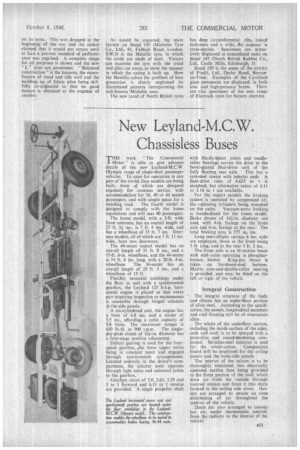New Leyland-M.C.W.
Page 55

If you've noticed an error in this article please click here to report it so we can fix it.
Chassisless Buses
THIS week "The Commercial 11. Motor" is able to give advance details of the new Leyland-M.C.W. Olympic range of single-deck passenger vehicles. To cater for operation in any part of the world, four models are being built, three of which are designed expressly for overseas service, with accommodation for 36, 40 or 44 seated passengers, and with ample space for a standing load. The fourth model is designed to comply with the home regulations and will seat 40 passengers.
The home model, with a 3-ft. wide front entrance, has an overall length of 27 ft, 5+ ins., is 7 ft. 4 ins, wide, and has a wheelbase of 15 ft. 7 ins. Overseas models, all of which are 7 ft. 11 ins. wide, have two doorways.
The 40-seater export model has an overall length of 31 ft. 8 ins., and a 17-ft. 6-in, wheelbase, and the 44-seater is 34 ft. 6 ins. long, with a 20-ft. 4-in. wheelbase. The 36-seater has an overall length of 29 ft. 3 ins., and a wheelbase of 15 ft.
Flexibly mounted amidships under the floor in unit with a synchromesh gearbox, the Leyland 125 b.h.p.. horizontal engine is placed so that every part requiring inspection or maintenance is accessible through hinged valances in the side panels.
A six-cylindered unit, the engine has • a bore of 4.8 ins, and a stroke of 5.5 ins., affording a cubic capacity of 9.8 litres. The maximum torque is
410 lb.--ft. at 900 r.p.m. The singledry-plate clutch of 16+-in, diameter has a four-stage positive adjustment.
Helical gearing is used for the fourspeed gearbox, ,the three upper ratios being in constant mesh and engaged through synchromesh arrangements. Located centrally in the driver's compartment. the selector lever operates through light tubes and universal joints to the gearbox.
Gearbox ratios of 5.0, 2.63, 1.59 and 1 to 1 forward and 6.13 to 1 reverse are provided. A single propeller shaft with Hardy-Spicer joints and needleroller bearings carries the drive to the bevel-geared final-drive unit of the fully floating rear axle. This has a cast-steel centre with tubular ends A final-drive ratio of 4.625 to 1 is standard, but alternative ratios of 4.11 or 5.14 to I are available.
For the export models the braking system is operated by compressed air, the operating cylinders being mounted on the axles. Vacuum-servo braking is standardized for the home model. Brake drums of 16I-in. diameter are used, with 4-in, facings on the front axle and 6-in, facings at the rear. The total braking area is 577 sq. ins.
Long semi-elliptic springs 4 ins. wide are employed, those at the front being 5 ft. long, and at the rear 5 ft. 2 ins.
The front axle is an H-section beam with stub axles operating in phosphorbronze bushes King-pin thrust is taken on hardened-steel buttons. Marles cam-and-double-roller steering is provided, and may be fitted on the left or right of the vehicle.
Integral Construction
' The integral structure of the body and chassis has an under-floor portion of alloy steel. According to the specification, the panels, longitudinal members and roof framing will be of aluminium alloy.
The whole of the underfloor section, including the inside surface of the sides, ends and roof, is to be sprayed with a protective and sound-deadening compound. Stainless-steel material is used for the wheel-arches. Composition board will be employed for the ceiling panels and the body-side panels.
The interior of the saloon is to be thoroughly ventilated, two electrically operated suction fans being provided in the front portion of the roof, which draw air from the outside through louvred intakes and force it into ducts formed in the ceiling side coves. Outlets are arranged to ensure an evert distribution of air throughout the interior of the vehicle.
Ducts are also arranged to convey hot air, under' thermostatic control. from the radiator to the interior of the vehicle.




















































































































